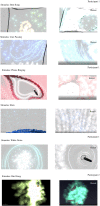Using immersive virtual reality to recreate the synaesthetic experience
- PMID: 37675441
- PMCID: PMC10478570
- DOI: 10.1177/20416695231166305
Using immersive virtual reality to recreate the synaesthetic experience
Abstract
Synaesthesia is a condition where people experience unusual sensory or cognitive sensations in response to apparently unrelated stimuli. This paper presents two experiments which aimed to examine whether Virtual Reality (VR) technology can be used to recreate the synaesthetic experience. There is a lack of research in this area, with most studies focussing primarily on synaesthetic colors. Experiment 1 aimed to build on previous research by using not only a traditional color-picker but also VR to capture a more nuanced picture of synaesthetic perception. A multiple case study design was used to examine the experiences of six participants in detail. Data gathering took place via Zoom. During the initial data-gathering session, participants used a color-picker to provide grapheme-color associations. After this session, some of the participants' synaesthetic experiences were recreated using a VR-by-proxy approach. Results indicated that VR is capable of capturing elements of synaesthetic perception that other methods have been unable to, such as texture, small degrees of movement, and 3D structure. Experiment 2 expanded upon these findings by moving beyond the VR-by-proxy approach and asking three participants to recreate their own audiovisual synaesthetic associations in the VR environment. Inductive Thematic Analysis was used to analyze the results of this experiment. The potential of expanding this technique to other forms of perceptual diversity is discussed.
Keywords: cross-modal correspondences; perception; synaesthesia; virtual reality.
© The Author(s) 2023.
Conflict of interest statement
The author(s) declared no potential conflicts of interest with respect to the research, authorship, and/or publication of this article.
Figures













Similar articles
-
Color opponency in synaesthetic experiences.Psychol Sci. 2007 Jun;18(6):481-6. doi: 10.1111/j.1467-9280.2007.01925.x. Psychol Sci. 2007. PMID: 17576258
-
Acquiring synaesthesia: insights from training studies.Front Hum Neurosci. 2014 Mar 3;8:109. doi: 10.3389/fnhum.2014.00109. eCollection 2014. Front Hum Neurosci. 2014. PMID: 24624072 Free PMC article. Review.
-
Do synaesthesia and mental imagery tap into similar cross-modal processes?Philos Trans R Soc Lond B Biol Sci. 2019 Dec 9;374(1787):20180359. doi: 10.1098/rstb.2018.0359. Epub 2019 Oct 21. Philos Trans R Soc Lond B Biol Sci. 2019. PMID: 31630660 Free PMC article.
-
Synaesthetic colour associations for Japanese Kanji characters: from the perspective of grapheme learning.Philos Trans R Soc Lond B Biol Sci. 2019 Dec 9;374(1787):20180349. doi: 10.1098/rstb.2018.0349. Epub 2019 Oct 21. Philos Trans R Soc Lond B Biol Sci. 2019. PMID: 31630661 Free PMC article.
-
Do Multisensory Stimuli Benefit the Virtual Reality Experience? A Systematic Review.IEEE Trans Vis Comput Graph. 2022 Feb;28(2):1428-1442. doi: 10.1109/TVCG.2020.3010088. Epub 2021 Dec 30. IEEE Trans Vis Comput Graph. 2022. PMID: 32746276
References
-
- Adobe Photoshop (1990). Adobe Inc [Computer Software].
-
- Adobe Premier Pro (2003). Adobe Inc [Computer Software].
-
- Audacity (2000). The Audacity Team [Computer Software].
-
- BBC News (2021). ‘Google’s Tilt Brush VR painting app goes open source.’ Retrieved from https://www.bbc.co.uk/news/technology-55826249.
LinkOut - more resources
Full Text Sources

